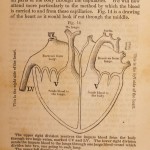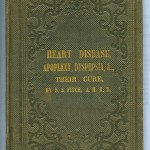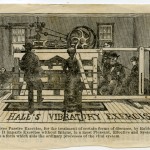Luckily, the American Antiquarian Society does not collect in all areas of human condition and experience.
An example of such an area?
Internal organs.
What we do have, however, is a rich collection around this object of study. And whereas February was American Heart Month, an opportunity in the calendar year to focus on the well-being of what we refer to colloquially as the ticker, we thought it fitting to extract some pieces from the collection to showcase how nineteenth-century Americans valued and studied this vital organ.
Each image in the virtual exhibit below can be clicked on to enlarge for closer examination.
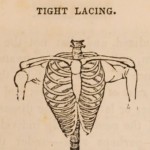 Health-related publications are an area well represented in the library. Soon after its first appearance on the American fashion scene, the now notorious corset was suspected as having less-than-beneficial side effects on the female body. This illustration inside Dr. William Alcott’s health tract Tight Lacing published in 1841, shows the deformation of the chest cavity resulting from wearing the garment. The author also devotes a section to injuries of the heart which resulted by practicing the style.
Health-related publications are an area well represented in the library. Soon after its first appearance on the American fashion scene, the now notorious corset was suspected as having less-than-beneficial side effects on the female body. This illustration inside Dr. William Alcott’s health tract Tight Lacing published in 1841, shows the deformation of the chest cavity resulting from wearing the garment. The author also devotes a section to injuries of the heart which resulted by practicing the style.
Publications such as home companions and health manuals proliferated during the era, since much health monitoring and hygiene fell under the purview of the domestic space. Catharine Beecher (1800-1878), the writer and innovative educator, penned Letters to the People on Health and Happiness in 1855. It is a more-or-less epistolary style piece which discusses laws of health, the functions of organs of the body as well as remedies and how they are created. Women, as keepers of the health of the home, would find these books central as reference material.
As well as magazines and home manuals, AAS also has examples of medical companions and the published form of delivered anatomical lectures. This example from A Popular Treatise on Diseases of the Heart published in 1859 by Samuel Sheldon Fitch (1801-1876) features illustrations of the structures of the heart and discusses ailments of the organ. Fitch also edited a periodical for general use called The Medical Exponent and Gazette of Health – the aim of both publications being the spread of popular medicine.
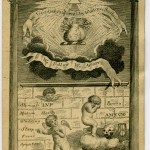 Anyone who has experience with the Society’s holdings knows of its vast graphic arts and ephemera collections. In the tickets collection, we have examples for anatomical lectures engraved with images of the heart. The item featured here is to see Doctor Alexander Ramsay (ca. 1754-1824); AAS also has several of Dr. Ramsay’s prospectuses for the lecture series. The ticket here is by engraver Francis Kearny (1785-1837) dated 1809 which granted its holder, Samuel A. Bradley Esquire, admission to “Anatomy and Physiology or the 1st Course No. 13” which likely included a live dissection of a cadaver.
Anyone who has experience with the Society’s holdings knows of its vast graphic arts and ephemera collections. In the tickets collection, we have examples for anatomical lectures engraved with images of the heart. The item featured here is to see Doctor Alexander Ramsay (ca. 1754-1824); AAS also has several of Dr. Ramsay’s prospectuses for the lecture series. The ticket here is by engraver Francis Kearny (1785-1837) dated 1809 which granted its holder, Samuel A. Bradley Esquire, admission to “Anatomy and Physiology or the 1st Course No. 13” which likely included a live dissection of a cadaver.
Other ephemera items include trade cards for bitters and other medical aids. Diet, exercise, and stress were quickly discovered to be culprits for ill heart-health, which gave advertisers a profitable stage to promote their goods. Machines such as “Hale’s Vibratory Exercise” featured on this trade card from circa 1870, promised to give “Passive Exercise” for the treatment of disease. (Many of AAS’s trade cards are available digitally through the Readex product, American Broadsides and Ephemera, which is available in the AAS reading room.)
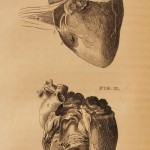 In addition to manuals and ephemera, AAS also has texts where the intended audience was the medical establishment and community. Frequently, these were illustrated. One such example is this engraving by prominent American artist Alexander Anderson (1775-1870) which shows the “Rupture of the Heart” a piece which appeared inside The Physico-Medical Society of New York Transactions published in New York in 1817. Anderson’s engraving appeared at the end of the piece “A Case of Sudden Death from a Rupture of the Left Ventricle of the Heart, with remarks” by Valentine Mott, M.D. read before his colleagues; it is constructed similarly to our contemporary medical journals.
In addition to manuals and ephemera, AAS also has texts where the intended audience was the medical establishment and community. Frequently, these were illustrated. One such example is this engraving by prominent American artist Alexander Anderson (1775-1870) which shows the “Rupture of the Heart” a piece which appeared inside The Physico-Medical Society of New York Transactions published in New York in 1817. Anderson’s engraving appeared at the end of the piece “A Case of Sudden Death from a Rupture of the Left Ventricle of the Heart, with remarks” by Valentine Mott, M.D. read before his colleagues; it is constructed similarly to our contemporary medical journals.
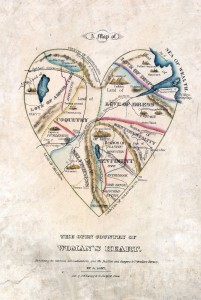 What investigative mission would be complete without the inclusion of the elusive 19th-century humorous print? This piece, a satirical, hand-colored lithograph entitled A Map of the Open Country of Woman’s Heart by Kellogg and Company published in 1833, shows such areas as “Dress” and “Coquetry” as chart-able regions of the female heart. Read more about the print in the AAS online exhibit, Beauty, Virtue, & Vice: Images of Women in Nineteenth Century American Prints.
What investigative mission would be complete without the inclusion of the elusive 19th-century humorous print? This piece, a satirical, hand-colored lithograph entitled A Map of the Open Country of Woman’s Heart by Kellogg and Company published in 1833, shows such areas as “Dress” and “Coquetry” as chart-able regions of the female heart. Read more about the print in the AAS online exhibit, Beauty, Virtue, & Vice: Images of Women in Nineteenth Century American Prints.
The objects featured here demonstrate that although it was not instituted until 1963 as American Heart Month, the heart nonetheless has remained vital in national mind, print – and, yes, heart. Each of the items discussed here are currently on display in the exhibit case in the AAS reading room. Since we got a late start celebrating American Heart Month, the exhibit will remain up in the reading room through March. If you are in the area and are interested in viewing these pieces, feel free to stop in for our public tour offered every Wednesday at 3pm to see them in person.

